More than 30 years after the federal Americans with Disabilities Act (ADA) was signed into law, Public Right-of-Way Accessibility Guidelines (PROWAG) have been written and recently approved as a final rule for pedestrian facilities in the public right-of-way.
What is PROWAG, and why is it important?
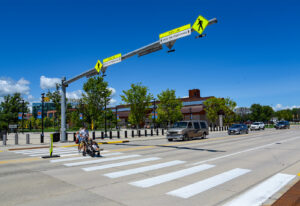 PROWAG responds to accessibility situations in the public right-of-way that the Americans with Disabilities Act Accessibility Guidelines (ADAAG) do not address. ADA guidelines were established primarily for buildings and access on private lands. However, since elements in the public right-of-way such as sidewalks, curb ramps, and street crossings can present challenges to accessibility, additional guidance was necessary to address conditions and constraints unique to public rights-of-way.
PROWAG responds to accessibility situations in the public right-of-way that the Americans with Disabilities Act Accessibility Guidelines (ADAAG) do not address. ADA guidelines were established primarily for buildings and access on private lands. However, since elements in the public right-of-way such as sidewalks, curb ramps, and street crossings can present challenges to accessibility, additional guidance was necessary to address conditions and constraints unique to public rights-of-way.
What is the history of the ADA, and how have those standards impacted the need for public right-of-way guidelines?
When the ADA was signed into law in 1990, there were 49 million people with disabilities. In 2022, there was a reported 59 million people with disabilities. The ADA is a civil rights law that prohibits discrimination against individuals with disabilities and is enforceable by the Department of Justice (DOJ). The United States has a long history of creating laws that addressed access for those with disabilities. Some of those laws include removing architectural barriers in buildings and redefining “handicapped” as “disabled.” In order to better define the issue, lawmakers adopted non-discriminatory laws, and the ADA set forth guidelines for construction or improvements that would apply to all workplaces regardless of funding.
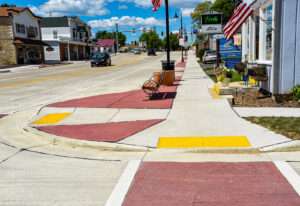 Guidelines were developed to help people know how to make the ADA standards possible. Many of the guidelines that were put in place as part of the passage of the ADA focused on access to buildings and improvements on private property. Designers and engineers have struggled over the years to adapt the ADA guidelines to the public right-of-way. When constructing a new building, elements of ADA can be integrated in the design of the structure. So, what happens on public property when the guidelines don’t “fit” the physical situation where accessibility improvements are desired? In some situations, there is not enough land to meet ADA guidelines. The question has been, “What should a public agency do, and what do they have to do?” The reference to ADA standards being considered “guidelines” created even more confusion as to when and how the standards are to be used.
Guidelines were developed to help people know how to make the ADA standards possible. Many of the guidelines that were put in place as part of the passage of the ADA focused on access to buildings and improvements on private property. Designers and engineers have struggled over the years to adapt the ADA guidelines to the public right-of-way. When constructing a new building, elements of ADA can be integrated in the design of the structure. So, what happens on public property when the guidelines don’t “fit” the physical situation where accessibility improvements are desired? In some situations, there is not enough land to meet ADA guidelines. The question has been, “What should a public agency do, and what do they have to do?” The reference to ADA standards being considered “guidelines” created even more confusion as to when and how the standards are to be used.
When were the rules for PROWAG issued, and who is the intended target audience for implementation?
In 1992, the U.S. Access Board began the rule-making process to address accessibility in public rights-of-way. In 2002, a draft was provided for comments and revisions. Unfortunately, it has taken until 2023 for the U.S. Access Board to issue a final rule for accessibility guidelines for pedestrian facilities in the public right-of-way. These guidelines inform federal, state, and local government agencies as to how to make their pedestrian facilities, such as sidewalks, crosswalks, shared-use paths, and on-street parking accessible to people with disabilities. The next step is for the rules to be adopted by the DOJ and the U.S. Department of Transportation (DOT). Once they are adopted by the DOJ and DOT, all entities will be obligated to comply with PROWAG. Both the DOT and DOJ intend to consider adoption of PROWAG into its regulations in 2024. Until the DOJ and DOT have adopted the regulations, states, counties, cities, villages, and towns should continue to follow existing ADA standards. DOJ and DOT regulations adopting accessibility standards in the public rights-of-way must be consistent with the U.S. Access Board’s final PROWAG rule. That rule established minimum guidelines of the regulations. Therefore, use of the minimum standards in the U.S. Access Board’s adopted PROWAG rule for current projects is recommended.
What type of projects must follow PROWAG guidelines?
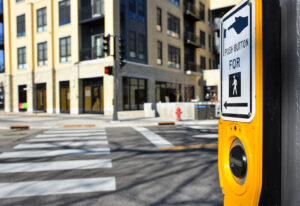 The U.S. Access Board has defined public right-of-way as “public land acquired for or dedicated to transportation purposes, or other land where there is a legally established right for use by the public for transportation purposes regardless of what that purpose may be, such as a pedestrian circulation path.” When the guidelines have been adopted by the DOJ and DOT, implementation of improvements that meet the guidelines is required for projects that are considered “alterations.” If “maintenance” is performed on a constructed project, then the guidelines do not need to be met. The following chart provides examples of alteration versus maintenance projects:
The U.S. Access Board has defined public right-of-way as “public land acquired for or dedicated to transportation purposes, or other land where there is a legally established right for use by the public for transportation purposes regardless of what that purpose may be, such as a pedestrian circulation path.” When the guidelines have been adopted by the DOJ and DOT, implementation of improvements that meet the guidelines is required for projects that are considered “alterations.” If “maintenance” is performed on a constructed project, then the guidelines do not need to be met. The following chart provides examples of alteration versus maintenance projects:
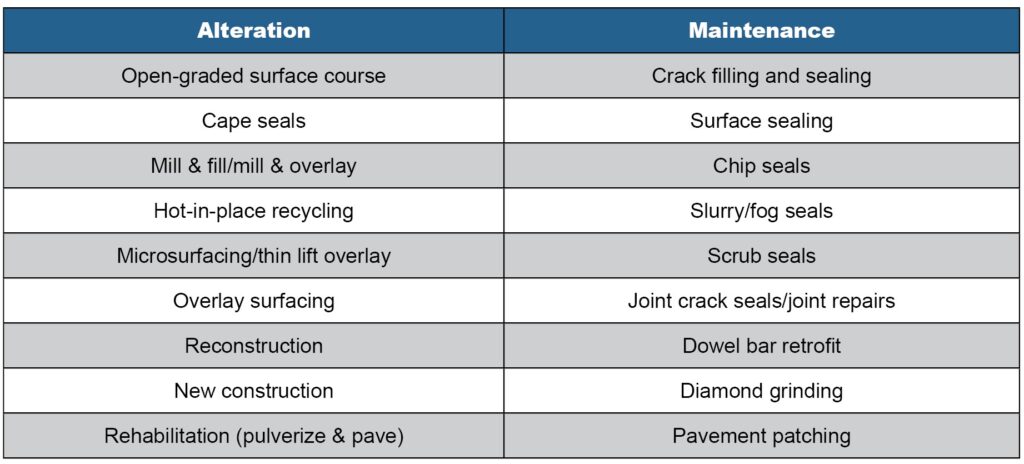 Curb ramps must be installed wherever a sidewalk or other pedestrian walkway crosses a curb. Many questions arise as to when curb ramps must be replaced. The following chart provides some guidelines:
Curb ramps must be installed wherever a sidewalk or other pedestrian walkway crosses a curb. Many questions arise as to when curb ramps must be replaced. The following chart provides some guidelines:
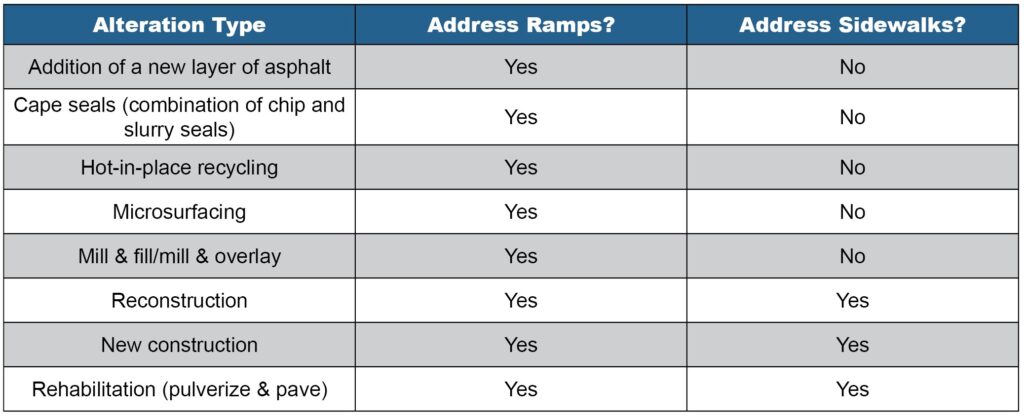 For alterations, where existing physical constraints make compliance with applicable requirements technically infeasible, compliance with these requirements is required to the maximum extent feasible. Existing physical constraints include, but are not limited to, underlying terrain, underground structures, adjacent developed facilities, drainage, or the presence of a significant natural or historic feature. (R202 3.1.)
For alterations, where existing physical constraints make compliance with applicable requirements technically infeasible, compliance with these requirements is required to the maximum extent feasible. Existing physical constraints include, but are not limited to, underlying terrain, underground structures, adjacent developed facilities, drainage, or the presence of a significant natural or historic feature. (R202 3.1.)
Following are some important considerations related to the accessibility of sidewalks, curb ramps, and street crossings under PROWAG.
- Sidewalks, shared paths, and other pedestrian ways must contain a “pedestrian accessible route”; that is, a route that is accessible and traversable by individuals with disabilities.
- If a pedestrian accessible route is closed, a temporary alternate route must be provided.
- All new and altered pedestrian signals must include accessible pedestrian signals with audio.
- Crosswalk curb ramps have very specific design requirements that must be met.
- On-street parking in non-residential areas must have designated stalls with room to gain access to a sidewalk without entering a vehicle way.
- Transit stops must provide accommodation for persons with disabilities to board.
- Any pedestrian facility altered must adhere to PROWAG regardless of the “scope of project.”
- If facilities are added to or altered, they are subject to the guidelines.
- Altered facilities must be connected to the existing pedestrian circulation.
How does PROWAG compare to 2010 ADA standards?
The chart below provides a snapshot of pedestrian accessibility routes under PROWAG with accessible routes under 2010 ADAAG.
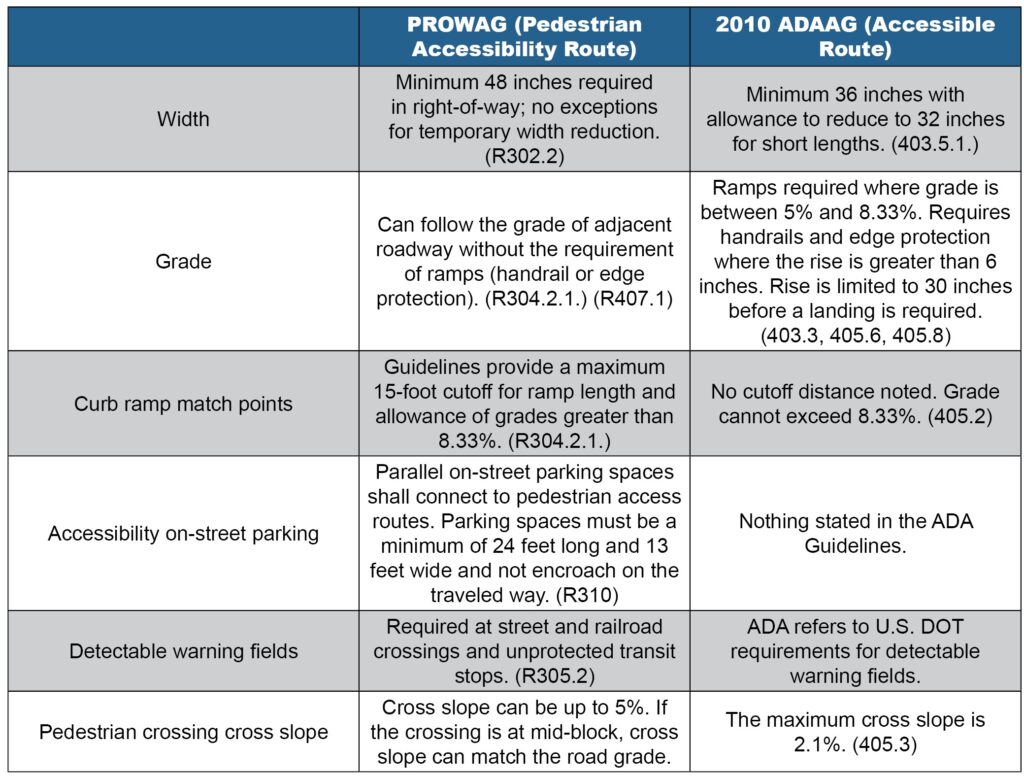 Although some agencies may see the introduction of PROWAG as just more laws to follow, others have embraced it since it removed ambiguity in the design of improvements within the public right-of-way. Designers and engineers should be sensitive to the needs of those with a disability and can easily incorporate accommodating design features into their public works projects.
Although some agencies may see the introduction of PROWAG as just more laws to follow, others have embraced it since it removed ambiguity in the design of improvements within the public right-of-way. Designers and engineers should be sensitive to the needs of those with a disability and can easily incorporate accommodating design features into their public works projects.
